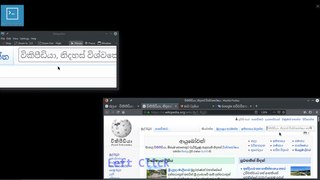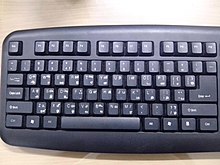
The Tibetan script is a segmental writing system (abugida) of Indic origin used to write certain Tibetic languages, including Tibetan, Dzongkha, Sikkimese, Ladakhi, Jirel and Balti. It has also been used for some non-Tibetic languages in close cultural contact with Tibet, such as Thakali and Old Turkic. The printed form is called uchen script while the hand-written cursive form used in everyday writing is called umê script. This writing system is used across the Himalayas, and Tibet.
The International Alphabet of Sanskrit Transliteration (IAST) is a transliteration scheme that allows the lossless romanisation of Indic scripts as employed by Sanskrit and related Indic languages. It is based on a scheme that emerged during the 19th century from suggestions by Charles Trevelyan, William Jones, Monier Monier-Williams and other scholars, and formalised by the Transliteration Committee of the Geneva Oriental Congress, in September 1894. IAST makes it possible for the reader to read the Indic text unambiguously, exactly as if it were in the original Indic script. It is this faithfulness to the original scripts that accounts for its continuing popularity amongst scholars.
ISO 15919 is one of a series of international standards for romanization by the International Organization for Standardization. It was published in 2001 and uses diacritics to map the much larger set of consonants and vowels in Brahmic and Nastaliq scripts to the Latin script.
Project Madurai is an open and voluntary initiative aimed at publishing free versions of ancient Tamil literature on the internet. Texts have been consistently published in both TSCII since its launch in 1998 and Unicode formats from 2004. The leadership of the project is attributed to Dr. K. Kalyanasundaram, based in Lausanne, Switzerland, serving as the Project Leader, and Dr. P. Kumar Mallikarjunan, located in Blacksburg, VA, USA, as the Deputy Project Leader.
InScript is the decreed standard keyboard layout for Indian scripts using a standard 104- or 105-key layout. This keyboard layout was standardised by the Government of India for inputting text in languages of India written in Brahmic scripts, as well as the Santali language, written in the non-Brahmic Ol Chiki script. It was developed by the Indian Government and supported by several public and private organisations. This is the standard keyboard for 12 Indian scripts including Devanagari, Bengali, Gujarati, Gurmukhi, Kannada, Malayalam, Odia, Tamil and Telugu, among others. The InScript layout is built into most of the major operating systems including Windows, and most Linux and Mac OS systems. It is also available in some mobile phones and in Apple's iOS 5 and higher. It is available in Android 4.0 and higher but removed from latest Google Keyboard application (Gboard) and Google Indic Keyboard. It is also available for Windows Mobile 5.x and 6.x from third parties.
Indic Computing means "computing in Indic", i.e., Indian Scripts and Languages. It involves developing software in Indic Scripts/languages, Input methods, Localization of computer applications, web development, Database Management, Spell checkers, Speech to Text and Text to Speech applications and OCR in Indian languages.
Sinhala language software for computers have been present since the late 1980s but no standard character representation system was put in place which resulted in proprietary character representation systems and fonts. In the wake of this CINTEC introduced Sinhala within the UNICODE standard. ICTA concluded the work started by CINTEC for approving and standardizing Sinhala Unicode in Sri Lanka.

Unicode input is the insertion of a specific Unicode character on a computer by a user; it is a common way to input characters not directly supported by a physical keyboard. Unicode characters can be produced either by selecting them from a display or by typing a certain sequence of keys on a physical keyboard. In addition, a character produced by one of these methods in one web page or document can be copied into another. In contrast to ASCII's 96 element character set, Unicode encodes hundreds of thousands of graphemes (characters) from almost all of the world's written languages and many other signs and symbols besides.

The Central Kurdish variety Sorani is mainly written using an Arabic alphabet with 33 letters. Unlike the regular Arabic script, which is an abjad, Kurdish Arabic is an alphabet in which vowels are mandatory.
Bengali input methods refer to different systems developed to type the characters of the Bengali script for Bengali language and others, using a typewriter or a computer keyboard.

Sinhala input methods are ways of writing the Sinhala language, spoken primarily in Sri Lanka, using a computer. Sinhala input methods can be broadly classified into two main groups: ones based on typewriter keyboard layouts, and ones that are meant to be typed on QWERTY keyboards using an input method, known as "Singlish".

Azhagi is a freeware transliteration tool, which enables its users to type in a number of regional Indian languages, including Tamil, Hindi, and others, using an English keyboard. In 2002, The Hindu dubbed Azhagi as a tool that "stand[s] out" among various similar software "emerg[ing] nearly every other day". Since year 2000, Azhagi has provided support for Tamil transliteration; this was later expanded to nearly 13 Indian languages, featuring 16 total built-in languages as of the day of writing.

The Tamil keyboard is used in computers and mobile devices to input text in the Tamil script.
Tamil All Character Encoding (TACE16) is a 16-bit Unicode-based character encoding scheme for Tamil language.
The Hanifi Rohingya script is a unified script for the Rohingya language. Rohingya today is written in three scripts, Hanafi, Arabic, and Latin (Rohingyalish). The Rohingya language was first written in the 19th century with a version of the Perso-Arabic script. In 1975, an orthographic Arabic script was developed and approved by the community leaders, based on the Urdu alphabet but with unique innovations to make the script suitable to Rohingya.
Windows Cyrillic + German is a modification of Windows-1251 that was used by Paratype to cover languages that use the Cyrillic script such as Russian, Bulgarian, and Serbian Cyrillic on a German language keyboard. This encoding was also used by Gamma Productions. This encoding is supported by FontLab Studio 5.
Windows Cyrillic + French is a modification of Windows-1251 that was used by Paratype to cover languages that use the Cyrillic script such as Russian and Bulgarian on a French language keyboard. This encoding was also used by Gamma Productions. This encoding is supported by FontLab Studio 5.
The Khmer keyboard includes several keyboard layouts for Khmer script.

Meitei input methods are the methods that allow users of computers to input texts in the Meitei script, systematically for Meitei language.

Bharati Script is a constructed script, and an abugida created by a research team led by V. Srinivasa Chakravarthy at IIT Madras. It is designed to serve as a common script or link script for Indian languages.









